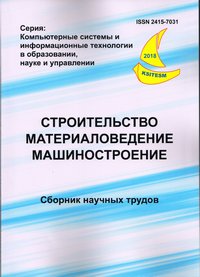Problems of application and automation of methods of evaluation of risks of projects of objects reconstruction
DOI:
https://doi.org/10.30838/P.CMM.2415.270818.58.230Keywords:
reconstruction project, risk management, methods for assessing risks in the construction industry, automation of risk management, operational (production) risks, softwareAbstract
The urgency of the problem. Process of reconstructing objects faces many challenges and risks. The problem of risk assessment in construction is of paramount importance. This is due to erosion of an increasing number of modern structures with extraordinary structural features and loads, increasingly world-wide scales of reconstruction in difficult geotechnical conditions with a high degree of responsibility in reconstruction of capital construction objects. Purpose - is to identify and consider application and automation of risk assessment of reconstruction projects. Methodology. The problem of automation of risk assessment of reconstruction projects to date hasn’t been properly addressed. This is largely due to use of technical and economic substantiation of objects of construction and reconstruction of methods for risk assessment, which doesn’t fully take into account the specifics of construction activity of objects and peculiarities of their exploitation. Investigation of existing quantitative and qualitative methods of risk management allows us to conclude that they need to be developed and improved to be used for design, construction, reconstruction, repair of construction objects. This is especially true of risk management in construction activities. The reason for this is changing prices for building materials and construction, transportation and operation of construction machinery, machinery and equipment, transportation of workers to construction sites, travel expenses when performing work in other regions. The brief description of each method is given in article. Features of their application are analyzed and revealed. Problems of use of risk management methodology in the management of building projects are formulated. Conclusions. To manage and automate risks of reconstruction projects, need to understand scope and objectives of software to use the appropriate automated risk management tool. The automated risk management tool doesn’t guarantee success, but serves main purpose of storing and analyzing identified problems, timely response. Definitely, each project is unique and requires adaptation and adjustment of selected automated tools for its practical implementation. This set of criteria should be defined for each specific project and consider the objectives of the implementation, the objectives of risk management process, the size of the reconstruction project and its needs, the ability to integrate with the required standards and methodologies.References
DBN V.1.2-14-2009. Zahalni pryntsypy zabezpechennia nadiinosti ta konstruktyvnoi bezpeky budivel, sporud, budivelnykh konstruktsii [General principles of maintenance of reliability and constructive safety of buildings, structures, building constructions]. Kyiv, Minrehionbud Ukrainy, 2009, 37 p. (in Ukrainian).
DSTU IES/ISO 31010:2013 (IES/ISO 31010:2009,IDT) Natsionalnyi standart Ukrainy. Keruvannia ryzykom. Metody zahalnoho otsiniuvannia ryzyku. [National standard of Ukraine. Risk management. Methods of general risk assessment]-2013-12-11. – Kyiv: Minekonomrozvytku Ukrainy, 2013, 141 p. (in Ukrainian).
Ermoshin N.A. and Lazarev Yu.H. Upravlenye tekhnycheskymy ryskamy pry proektyrovanyy y stroytelstve [Management of technical risks in the design and construction]//«Sovremennыe kontseptsyy nauchnыkh yssledovanyi».// IV Mezhdunarodnaia nauchno-praktycheskaia konferentsyia (tekhnycheskye nauky), Moscow 26-27.09.2014 h.// Evraziyskiy soyuz uchenykh (ESU) Ezhemesyachnyy nauchnyy zhurnal no. 6/2014, issue 3, pp. 73-77. (in Russian).
Morozova T.F. and Kinajat L.A. Otsinka ryzykiv v budivnytstvi [Risk assessment and safety in construction] (electronic resource) // Budivnytstvo unikalnykh budivel i sporud. 2013, no. 5(10), pp. 68-76. – Available at: http://unistroy.spb.ru/index_2013_10/6_morozova_kinayats_10.pdf (in Ukrainian).
Ulytskiy V.M. and Lisyuk M.B. Otsenka riska i obespecheniye bezopasnosti v stroitelstve [Risk assessment and security in construction]/ V.M. Ulytskyi, // Rekonstruktsiya gorodov i geotekhnicheskoye stroitelstvo. Moscow, 2003. no. 5. pp. 160−166. (in Russian).
Raskwitz R. Acceptable risk and affordable risk control for technical facilities and optimization, submitted for publication / R. Raskwitz // Reliability engineering and systems safety. – 2003.
Downloads
Published
Issue
Section
License
Редакція Видання категорично засуджує прояви плагіату в статтях та вживає всіх можливих заходів для його недопущення. Плагіат розглядається як форма порушення авторських прав і наукової етики.
При виявлені у статті більш ніж 25% запозиченого тексту без відповідних посилань та використання лапок, стаття кваліфікується як така, що містить плагіат. У цьому випадку стаття більше не розглядається редакцією, а автор отримує перше попередження.
Автори, в статтях яких повторно виявлено плагіат, не зможуть публікуватися в усіх журналах Видавництва ДВНЗ «Придніпровська державна академія будівництва та архітектури».
Автори, які публікуються у цьому журналі, погоджуються з наступними умовами:
- Автори залишають за собою право на авторство своєї роботи та передають журналу право першої публікації цієї роботи на умовах ліцензії Creative Commons Attribution License, котра дозволяє іншим особам вільно розповсюджувати опубліковану роботу з обов'язковим посиланням на авторів оригінальної роботи та першу публікацію роботи у цьому журналі.
- Автори мають право укладати самостійні додаткові угоди щодо неексклюзивного розповсюдження роботи у тому вигляді, в якому вона була опублікована цим журналом (наприклад, розміщувати роботу в електронному сховищі установи або публікувати у складі монографії), за умови збереження посилання на першу публікацію роботи у цьому журналі.
- Політика журналу дозволяє і заохочує розміщення авторами в мережі Інтернет (наприклад, у сховищах установ або на особистих веб-сайтах) рукопису роботи, як до подання цього рукопису до редакції, так і під час його редакційного опрацювання, оскільки це сприяє виникненню продуктивної наукової дискусії та позитивно позначається на оперативності та динаміці цитування опублікованої роботи (див. The Effect of Open Access).

